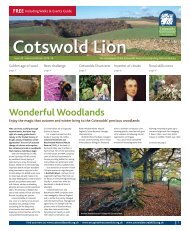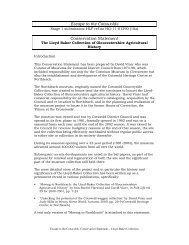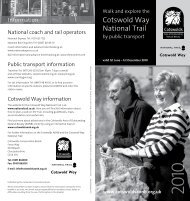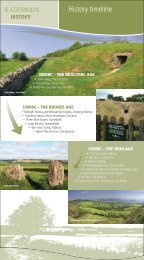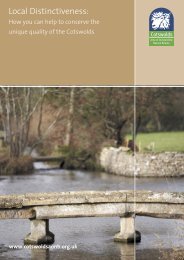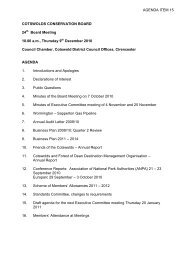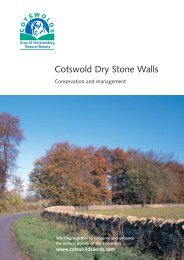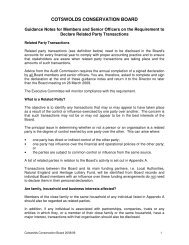AONB LCAR S1 P1-10 FINAL - the Cotswolds Area of Outstanding ...
AONB LCAR S1 P1-10 FINAL - the Cotswolds Area of Outstanding ...
AONB LCAR S1 P1-10 FINAL - the Cotswolds Area of Outstanding ...
You also want an ePaper? Increase the reach of your titles
YUMPU automatically turns print PDFs into web optimized ePapers that Google loves.
2 Evolution <strong>of</strong> <strong>the</strong> Landscape<br />
NOTGROVE LONG BARROW<br />
<strong>Cotswolds</strong> are <strong>of</strong>ten faced with dry stone masonry using<br />
<strong>the</strong> local limestone and sometimes contain internal stone<br />
built chambers, which may have remained in use for<br />
centuries. Tribal affiliations, or at least some form <strong>of</strong><br />
perceived sense <strong>of</strong> sameness, may be reflected in <strong>the</strong> fact<br />
that Cotswold stone was incorporated in <strong>the</strong> famous long<br />
mound at West Kennet although it is not clear whe<strong>the</strong>r<br />
<strong>the</strong> tombs builders transported <strong>the</strong> stone here or whe<strong>the</strong>r<br />
it was carried to <strong>the</strong> area by earlier glacial episodes. The<br />
re-constructed chambered tomb at Belas Knap, above<br />
Winchcombe provides a good example <strong>of</strong> <strong>the</strong> original<br />
appearance <strong>of</strong> <strong>the</strong>se features.<br />
Archaeologists consider that <strong>the</strong> concern shown by<br />
Neolithic people for <strong>the</strong>ir dead can be interpreted as a<br />
belief in <strong>the</strong> power <strong>of</strong> ancestors and <strong>the</strong> use <strong>of</strong> this power<br />
to support territorial claims on <strong>the</strong> landscape by sedentary,<br />
farming communities. The location <strong>of</strong> Neolithic tombs in<br />
<strong>the</strong> landscape may help to support this belief; for example,<br />
<strong>the</strong> string <strong>of</strong> long barrows and chambered tombs such as<br />
Hetty Peglar’s Tump and Belas Knap occupy prominent<br />
and dramatic locations overlooking <strong>the</strong> Severn and<br />
Evesham Vales respectively. It is not unreasonable to see<br />
<strong>the</strong>se as markers demarcating a particular territory for<br />
<strong>the</strong> communities that were probably living in <strong>the</strong> valleys<br />
<strong>of</strong> <strong>the</strong> dip-slope to <strong>the</strong> east.<br />
It is likely that during <strong>the</strong> Neolithic increasingly large<br />
areas <strong>of</strong> woodland were cleared for cultivation and it is<br />
within open landscapes that <strong>the</strong>se impressive landscape<br />
monuments would gain visual prominence. However,<br />
evidence for this is patchy. Charcoal taken from beneath<br />
<strong>the</strong> Nympsfield Long Barrow has been dated to around<br />
2200 BC and indicates that a wooded landscape <strong>of</strong><br />
hawthorn, hazel beech, ash, horse chestnut, cherry, oak,<br />
yew, elder and alder was present prior to its construction.<br />
One can infer from <strong>the</strong> site <strong>of</strong> such a monument that part<br />
<strong>of</strong> its drama and power came from its wide visibility<br />
and to achieve this much <strong>of</strong> <strong>the</strong> local woodland would<br />
have needed to be felled, and potentially kept from<br />
22<br />
<strong>Cotswolds</strong> <strong>AONB</strong> Partnership<br />
regenerating by extensive grazing <strong>of</strong> sheep or cattle.<br />
Excavations <strong>of</strong> <strong>the</strong> long barrow at Ascott-under-<br />
Wychwood in <strong>the</strong> Evenlode Valley, dated to approximately<br />
2800 BC, confirm this. Analysis <strong>of</strong> <strong>the</strong> findings also<br />
revealed that prior to its construction, <strong>the</strong> site had been<br />
subject to a pattern <strong>of</strong> settlement and abandonment from<br />
<strong>the</strong> Mesolithic period and that in between occupation<br />
phases, forest and scrub was allowed to regenerate.<br />
The absence <strong>of</strong> Neolithic settlement sites in <strong>the</strong><br />
archaeological record for <strong>the</strong> <strong>Cotswolds</strong> partly relates to<br />
<strong>the</strong>ir ephemeral nature, but also probably points to <strong>the</strong><br />
importance <strong>of</strong> water in establishing a suitable place to set<br />
up a permanent settlement. Most villages were likely to<br />
have been sited in valleys, in view <strong>of</strong> <strong>the</strong> monuments<br />
located on <strong>the</strong> hills above, and also located close to<br />
permanent springs. The concern for a reliable source <strong>of</strong><br />
water has to a great extent governed <strong>the</strong> site <strong>of</strong> existing<br />
villages and towns. It is likely, <strong>the</strong>refore, that Neolithic<br />
villages are simply buried beneath <strong>the</strong> valley villages that<br />
exist throughout <strong>the</strong> <strong>Cotswolds</strong> today. Contrary to this<br />
picture, however, is <strong>the</strong> discovery <strong>of</strong> a causewayed camp<br />
on Crickley Hill. This encampment was encircled by two<br />
interrupted ditches, <strong>the</strong> stone outcast from which was<br />
piled into embankments on <strong>the</strong> outer sides. Although no<br />
occupation evidence such as post-holes or storage-pits<br />
have been discovered which can be attributed to this<br />
period, <strong>the</strong> discovery <strong>of</strong> hundreds <strong>of</strong> flint arrowheads<br />
embedded in <strong>the</strong> ramparts proves that <strong>the</strong> site was at least<br />
used as a place <strong>of</strong> refuge. Traces <strong>of</strong> a burned palisade atop<br />
<strong>the</strong> defences are co-incident with <strong>the</strong> termination <strong>of</strong> this<br />
first occupation period, which is thought to have lasted<br />
between 3,500 and 2,500 BC.<br />
BELAS KNAP



